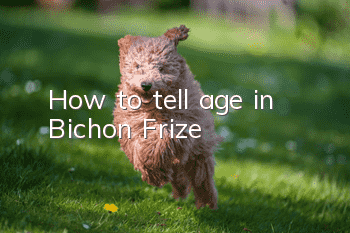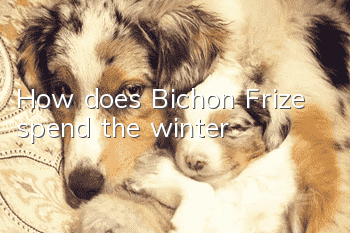How to tell age in Bichon Frize

1.Tooth status
Under 2 months old, there are only deciduous teeth (white, thin, sharp), incisors are replaced at 2-4 months, canine teeth (white, rounded tips) are replaced at 4-6 months, molars 1 are replaced at 6-10 months Teeth at the age of 2 are straight, white and bright, and the incisors have no cusps. At 2 years old, the cusp processes of the lower incisors are smoothed out. At 3 years old, the cusp processes of the upper incisors are smoothed out. At 4-5 years old, the upper and lower incisors begin to wear and become slightly beveled and yellow. 6- At the age of 8, the incisors are worn and the roots of the teeth are exposed, and the canine teeth are yellowed and worn on the lips. The tooth wear of dogs is related to their age. The older they are, the more serious the wear will be. But it should also be noted that this has a lot to do with the nature of the animal's food. For example, if the dog often eats soft food and often chews bones, the dog's tooth wear will be different, so it can only be used as a reference.
2. Hair condition
The occurrence of senile hair refers to the appearance of gray and white hair (that is, the original non-gray hair of dogs turns into gray and white hair). It first occurs in the lip area and mandibular area. Dogs aged 4-5 years old begin to see a few white hairs, and the number increases significantly at 5-6 years old. Later, it spreads to the back, around the nose, eyelids, eyebrows, etc., and then further extends to the forehead and external auditory canal. The hair on the entire head turns white. Dogs over 10 years old have a lot of white hair on their forehead, face and front of their head. After 13 years old, the entire head turns white (some dogs still have the same coat color when they are 10-14 years old). For dogs with white, yellow and white hair or chestnut hair with white spots, coat color change cannot be used as an auxiliary means to judge age.
3. Mental state
Posture: Young dogs are light and nimble when moving. When they are 2-5 years old, their movements are somewhat clumsy, but stable, safe and reliable. Elderly dogs over 10 years old have sluggish behavior, crooked or bent backs, and walk slowly.
Dogs with facial expressions aged about 1 year old have active expressions, lively and active eyes. Dogs aged 2-4 years old are approachable, energetic and enthusiastic. Old dogs older than 7 years old have sluggish energy, slow response to stimulation, unwillingness to move much, and dull eyes.
Young dogs have bright eyes. Cataracts appear in the eyes of dogs over 7 years old. Cataracts occur more frequently in dogs over 8 years old. Most dogs between 9 and 10 years old have cataracts. Almost all dogs over 10 years old have cataracts. . The lens of early cataract appears as a blue-green ring. Typical cataracts are central or pericentral, with lens opacity in gray or off-white color and obvious green refractive reflection.
- What should I do if my golden retriever puppy barks at night?
- How to make Teddy's fur fluffy
- How to clean teddy dog tear stains
- What should I do if my teddy dog has bad hair?
- When does Schnauzer change its coat?
- What should I do if my Chihuahua is too timid?
- What should I do if my Chihuahua smells bad?
- When will French Bulldog teeth grow in?
- What is the reason for Pomeranian’s coat to turn yellow?
- What should I do if my little golden retriever is naughty?



